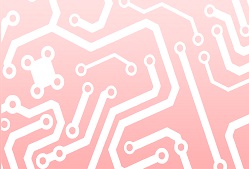Recycling of Circuit Boards by Robot Manipulator Using Stereo Vision and Deep Learning
Keywords:
formatting, style, stylingAbstract
To make possible the recycling of printed circuit boards, automated systems for object classification and degree of overlapping are needed. In this thesis, a recycling system with a robot manipulator was developed by using Deep learning and a stereo vision approach. The system operates in the following order: object detection by deep learning, calculation of 3D point clouds by stereo vision, and grasping by the robot manipulator. Four experiments were conducted to evaluate the developed recycling system. The four experiments were: measurement of object detection accuracy, measurement of stereo vision responsiveness, measurement of vertical judgment accuracy and grasping accuracy, and operation test of the actual machine. Deep learning and stereo vision for the robot manipulator were found to be effective for the printed circuit board recycling system. The results also shed light on the challenges of automating the recycling process.
References
I. Stobbe, K. Schrank, C.Weickardt, H. Griese, H. Reichl, and L. Stobbe, “Quality assured disassembly of electronic components for resue,” in Proc. IEEE Int. Symp. Electron. Environ., San Francisco, CA, May 6–9, 2002, pp. 299–305.
S. Yokoyama, K. Ikuta, and M. Iji, “Recycling system for printed wiring boards with mounted parts,” in Proceedings of First Int. Symposium on Environmentally Conscious Design and Inverse Manufacturing, 1999, pp. 814–817.
K. Feldmann and H. Scheller, “The printed circuit board-a challenge for automated disassembly and for the design of recyclable interconnect devices,” in Conference on Clean Electronic Products and Technology Concept, no. 415, 1995, pp. 186–190.
H. Zebedin, K. Daichendt, and P.Kopacek, “A newstrategy for a flexible semi-automatic disassembling cell of printed circuit boards,” in Proc. IEEE Int. Symp. Industrial Electronics—ISlE 2001, Pusan, Korea, June 2001, pp. 12–16.
J. B. Legarth, “Recycling of electronic scrap,” Ph.D. dissertation, Tech. Univ. Denmark Lyngby, 2002.
P. Galbraith and J. L. Devereux, Beneficiation of Printed Wiring Board With Gravity Concentration: Concurrent Technologies Corporation, International Association of Electronics Recyclers, 2002.
K. Feldmann and H. Scheller, “The printed circuit board-a challenge for automated disassembly and for the design of recyclable interconnect devices,” in Conference on Clean Electronic Products and Technology Concept, no. 415, 1995, pp. 186–190.
D. Hossain, G. Capi, M. Jindai and S. Kaneko, “Pick-place of dynamic objects by robot manipulator based on deep learning and easy user interface teaching systems,” Industrial Robot, vol. 44, issue 1, pp. 11-20, January 2017.
MA Keyvanrad, and MM Homayounpour, “A brief survey on deep belief networks and introducing a new object oriented MATLAB toolbox (DeeBNet V2.0)”, arXiv:14083264 (2015).
G. E. Hinton, S. Osindero, and Y.-W. Teh : “A Fast Learning Algorithm for Deep Belief Nets”, Neural Computation, Vol. 18, No. 7, pp. 1527–1554 (2006).
A. Mohamed, G. Dahl, and G. Hinton, “Deep Belief Networks for phone recognition”, NIPS Workshop on Deep Learning for Speech Recognition and Related Applications, Canada, pp. 1–9 (2009).
V. Nair and G. Hinton : “3D Object Recognition with Deep Belief Nets”, Advances in Neural Information Processing Systems 22, pp: 1339-1347 (NIPS 2009).
B. Leng, X. Zhang, M. Yao, and Z. Xiong, “3D Object Classification Using Deep Belief Networks”, MultiMedia Modeling, Vol. 8326, pp 128-139 (2014).
A. Hasasneh, E. Frenoux, and P. Tarroux, “Semantic Place Recognition Based on Deep Belief Networks and Tiny Images”, 9th International Conference on Informatics in Control, Automation and Robotics ICINCO, 2012, Rome, Italy.
I. Lenz, H. Lee, and A. Saxena, “Deep Learning for Detecting Robotic Grasps”, International Journal of Robotics Research, Vol. 34, No. 4-5, pp 705-724 (2015).
K.Naito,et al.:Recycling of printed circuit boards by robot manipulator: A Deep Learning Approach,2021 IEEE International Symposium on Robotic and Sensors Environments (ROSE),2021
S.Ren,et al.:Faster R-CNN: Towards Real-Time Object Detection with Region Proposal Networks,arXvi,Cornell University,https://arxiv.org/pdf/1506.01497.pdf,6 Jan 2016
R.Hartley,and A.Zisserman :Multiple View Geometry in Computer Vision,Cambridge University Press,25 May 2004.

Downloads
Published
How to Cite
Issue
Section
License
Copyright (c) 2023 Yuho Takahashi, Goragod Pongthanisorn, Genci Capi

This work is licensed under a Creative Commons Attribution-NonCommercial 4.0 International License.
License Terms:
Except where otherwise noted, content on this website is lincesed under a Creative Commons Attribution Non-Commercial License (CC BY NC)
![]()
Use, distribution and reproduction in any medium, provided the original work is properly cited and is not used for commercial purposes, is permitted.
Copyright to any article published by WiPiEC retained by the author(s). Authors grant WiPiEC Journal a license to publish the article and identify itself as the original publisher. Authors also grant any third party the right to use the article freely as long as it is not used for commercial purposes and its original authors, citation details, and publisher are identified, in accordance with CC BY NC license. Fore more information on license terms, click here.